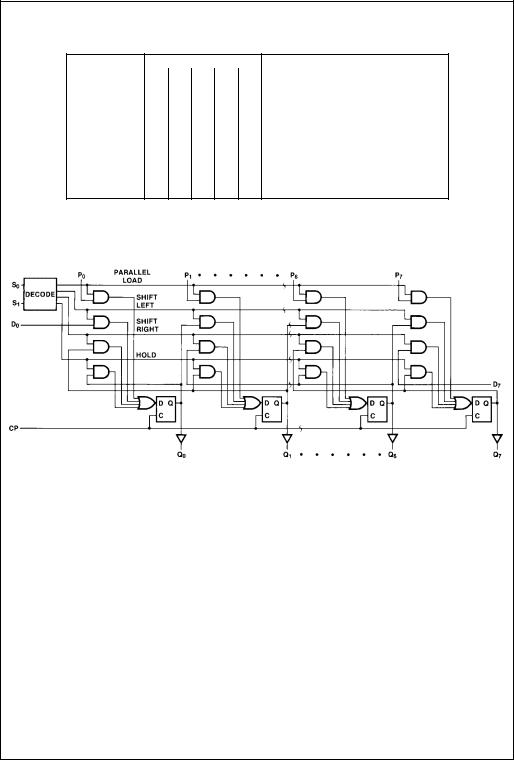Fairchild Semiconductor 100341SCX, 100341QIX, 100341QI, 100341QCX, 100341QC Datasheet
...
July 1988
Revised August 2000
100341
Low Power 8-Bit Shift Register
General Description |
Features |
|
The 100341 contains eight edge-triggered, D-type flip-flops |
■ 35% power reduction of the 100141 |
|
with individual inputs (Pn) and outputs (Qn) for parallel |
■ 2000V ESD protection |
|
operation, and with serial inputs (Dn) and steering logic for |
■ Pin/function compatible with 100141 |
|
bidirectional shifting. The flip-flops accept input data a |
■ Voltage compensated operating range = − 4.2V to − 5.7V |
|
setup time before the positive-going transition of the clock |
||
■ Available to industrial grade temperature range |
||
pulse and their outputs respond a propagation delay after |
||
|
||
this rising clock edge. |
|
The circuit operating mode is determined by the Select inputs S0 and S1, which are internally decoded to select either “parallel entry”, “hold”, “shift left” or “shift right” as described in the Truth Table. All inputs have 50 kΩ pulldown resistors.
Ordering Code:
Order Number |
Package Number |
Package Description |
|
|
|
10034SC |
M24B |
24-Lead Small Outline Integrated Circuit (SOIC), JEDEC MS-013, 0.300 Wide |
|
|
|
100341PC |
N24E |
24-Lead Plastic Dual-In-Line Package (PDIP), JEDEC MS-010, 0.400 Wide |
|
|
|
100341QI |
V28A |
28-Lead Plastic Lead Chip Carrier (PLCC), JEDEC MO-047, 0.450 Square |
|
|
|
100341QC |
V28A |
28-Lead Plastic Lead Chip Carrier (PLCC), JEDEC MO-047, 0.450 Square |
|
|
Industrial Temperature Range (− 40° C to + 85° C) |
|
|
|
Devices also available in Tape and Reel. Specify by appending the suffix letter “X” to the ordering code.
Logic Symbol |
Connection Diagrams |
|
24-Pin DIP/SOIC |
Pin Descriptions
Pin Names |
Description |
28-Pin PLCC |
|
|
|
CP |
Clock Input |
|
S0, S1 |
Select Inputs |
|
D0, D7 |
Serial Inputs |
|
P0–P7 |
Parallel Inputs |
|
Q0–Q7 |
Data Outputs |
|
Register Shift Bit-8 Power Low 100341
© 2000 Fairchild Semiconductor Corporation |
DS009880 |
www.fairchildsemi.com |

100341
Truth Table
Function |
|
|
Inputs |
|
|
|
|
|
Outputs |
|
|
|
|
|
D7 |
D0 |
S1 |
S0 |
CP Q7 |
Q6 |
Q5 |
Q4 |
Q3 |
Q2 |
Q1 |
Q0 |
|
Load Register |
X |
X |
L |
L |
|
P7 |
P6 |
P5 |
P4 |
P3 |
P2 |
P1 |
P0 |
Shift Left |
X |
L |
L |
H |
Q6 |
Q5 |
Q4 |
Q3 |
Q2 |
Q1 |
Q0 |
L |
|
Shift Left |
X |
H |
L |
H |
Q6 |
Q5 |
Q4 |
Q3 |
Q2 |
Q1 |
Q0 |
H |
|
Shift Right |
L |
X |
H |
L |
|
L |
Q7 |
Q6 |
Q5 |
Q4 |
Q3 |
Q2 |
Q1 |
Shift Right |
H |
X |
H |
L |
|
H |
Q7 |
Q6 |
Q5 |
Q4 |
Q3 |
Q2 |
Q1 |
Hold |
X |
X |
H |
H |
X |
|
|
|
|
|
|
|
|
Hold |
X |
X |
X |
X |
H |
|
|
|
No Change |
|
|
|
|
Hold |
X |
X |
X |
X |
L |
|
|
|
|
|
|
|
|
H = HIGH Voltage Level
L = LOW Voltage Level
X = Don’t Care
= LOW-to-HIGH Transition
Logic Diagram
www.fairchildsemi.com |
2 |

Absolute Maximum Ratings(Note 1)
Storage Temperature (TSTG) |
− 65° C to + 150° C |
Maximum Junction Temperature (TJ) |
+ 150° C |
VEE Pin Potential to Ground Pin |
− 7.0V to + 0.5V |
Input Voltage (DC) |
VEE to + 0.5V |
Output Current (DC Output HIGH) |
− 50 mA |
ESD (Note 2) |
≥ 2000V |
Recommended Operating
Conditions
Case Temperature (TC) |
|
Commercial |
0° C to + 85° C |
Industrial |
− 40° C to + 85° C |
Supply Voltage (VEE) |
− 5.7V to − 4.2V |
Note 1: The “Absolute Maximum Ratings” are those values beyond which the safety of the device cannot be guaranteed. The device should not be operated at these limits. The parametric values defined in the Electrical Characteristics tables are not guaranteed at the absolute maximum rating. The “Recommended Operating Conditions” table will define the conditions for actual device operation.
Note 2: ESD testing conforms to MIL-STD-883, Method 3015.
Commercial Version |
|
|
|
|
|
|
|
|
|
|
DC Electrical Characteristics |
(Note 3) |
|
|
|
|
|
|
|||
VEE = − 4.2V to − 5.7V, VCC = VCCA = |
GND, TC = 0° C to + 85° C |
|
|
|
|
|
|
|||
Symbol |
Parameter |
|
Min |
Typ |
Max |
Units |
|
Conditions |
|
|
|
|
|
|
|
|
|
|
|
|
|
VOH |
Output HIGH Voltage |
|
− 1025 |
− 955 |
− 870 |
mV |
VIN = |
VIH (Max) |
Loading with |
|
VOL |
Output LOW Voltage |
|
− 1830 |
− 1705 |
− 1620 |
mV |
or VIL (Min) |
50Ω |
to − 2.0V |
|
VOHC |
Output HIGH Voltage |
|
− 1035 |
|
|
mV |
VIN = |
VIH (Min) |
Loading with |
|
VOLC |
Output LOW Voltage |
|
|
|
− 1610 |
mV |
or VIL (Max) |
50Ω |
to − 2.0V |
|
VIH |
Input HIGH Voltage |
|
− 1165 |
|
− 870 |
mV |
Guaranteed HIGH Signal |
|
|
|
|
|
|
|
|
|
|
for all Inputs |
|
|
|
|
|
|
|
|
|
|
|
|
|
|
VIL |
Input LOW Voltage |
|
− 1830 |
|
− 1475 |
mV |
Guaranteed LOW Signal |
|
|
|
|
|
|
|
|
|
|
for all Inputs |
|
|
|
|
|
|
|
|
|
|
|
|
|
|
IIL |
Input LOW Current |
|
0.50 |
|
|
µ A |
VIN = |
VIL (Min) |
|
|
IIH |
Input HIGH Current |
|
|
|
240 |
µ A |
VIN = |
VIH (Max) |
|
|
IEE |
Power Supply Current |
|
|
|
|
|
Inputs OPEN |
|
|
|
|
|
|
− 157 |
|
− 75 |
mA |
VEE = |
− 4.2V to − 4.8V |
|
|
|
|
|
− 167 |
|
− 75 |
mA |
VEE = |
− 4.2V to − 5.7V |
|
|
Note 3: The specified limits represent the “worst case” value for the parameter. Since these values normally occur at the temperature extremes, additional noise immunity and guardbanding can be achieved by decreasing the allowable system operating ranges. Conditions for testing shown in the tables are chosen to guarantee operation under “worst case” conditions.
DIP AC Electrical Characteristics
VEE = − 4.2V to − 5.7V, VCC = |
VCCA = GND |
|
|
|
|
|
|
|
|
||
Symbol |
Parameter |
TC = 0° C |
TC = + 25° C |
TC = + 85° C |
Units |
Conditions |
|||||
|
|
|
Min |
Max |
Min |
Max |
Min |
Max |
|
|
|
|
|
|
|
|
|
|
|
|
|
||
fMAX |
Max Clock Frequency |
400 |
|
400 |
|
400 |
|
MHz |
Figures 2, 3 |
||
tPLH |
Propagation Delay |
|
0.90 |
1.90 |
1.00 |
2.00 |
1.00 |
2.10 |
ns |
Figures 1, 3 |
|
tPHL |
CP to Output |
|
(Note 4) |
||||||||
|
|
|
|
|
|
|
|
||||
tTLH |
Transition Time |
|
0.35 |
1.30 |
0.35 |
1.30 |
0.35 |
1.30 |
ns |
Figures 1, 3 |
|
tTHL |
20% to 80%, 80% to 20% |
||||||||||
|
|
|
|
|
|
|
|
||||
tS |
Setup Time |
Dn, Pn |
0.65 |
|
0.65 |
|
0.65 |
|
ns |
|
|
|
|
Sn |
1.60 |
|
1.60 |
|
1.60 |
|
|
Figure 4 |
|
tH |
Hold |
Dn, Pn |
0.80 |
|
0.80 |
|
0.80 |
|
ns |
||
|
|
|
|
||||||||
|
|
Sn |
0.60 |
|
0.60 |
|
0.60 |
|
|
|
|
tPW(H) |
Pulse Width HIGH |
CP |
2.00 |
|
2.00 |
|
2.00 |
|
ns |
Figure 3 |
|
Note 4: The propagation delay specified is for the switching of a single output. Delays may vary up to 0.40 ns if multiple outputs are switching simultaneously.
100341
3 |
www.fairchildsemi.com |
